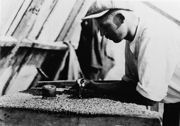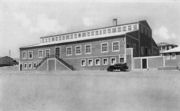|
|
||
|
|
Content | Look inside | Reviews | Sales Look Inside ELIZABETH BAY AND HANS HÖRLEIN About 30 km south of Lüderitz, the elements have shaped a 3km long beach into a bay that faces south into the relentless forces of the Benguela current and the prevailing southerly winds. For millions of years they have been using the surge of the tide to winnow ashore the marine detritus being washed up along the coast and funnelled between the mainland and the 10km distant Possession Island. On any given day, when the wind isn’t howling sand and spray into your eyes, you can walk there past crabs, pretty seashells, the occasional dead whale, a hauled out seal or two and likely as not a derelict lifeboat. The end of the unnaturally wide beach is demarcated by a string of low hummock dunes beyond which a roughly two square kilometre saltpan turns into a wide, shallow valley that gradually fades northeast into the desert shimmer in the direction of Kolmanskuppe. Elisabeth was not, as some would have it, the queen of England, but in fact the sister-in-law, Élisabeth, of the captain of a French survey vessel that did a stint along the coast in the early years. A bit of a backhanded compliment that one, because in facing the “wrong way” the bay is, as pretty as it may be, completely useless from a nautical point of view. It is therefore all the more ironic that this little bay, all but completely ignored for hundreds of years after being mapped, would, within the span of a mere 66 years, twice witness the erection of the most modern diamond mine in the world. For also here, in the southernmost corner of his concession area, Stauch’s KBG would discover diamonds. Mining had already commenced in 1911. But it had soon transpired that, in spite of the fact that the Elizabeth Bay diamonds were larger than those found at Kolmanskuppe (four to five stones to the carat as opposed to six), the erratic grade and distribution of the ore deposit was such that it soon became obvious that only a very large-scale operation would be viable. With neither the technical know-how nor the requisite capital available in the early years, the project was initially put on the back burner while easier pickings elsewhere were concentrated upon. But finally, in 1923, after having gotten over WWI, the resultant diamond market collapse and the change of ownership, the time to unlock the riches of Elizabeth Bay was deemed to have arrived. The man tasked with this project was Hans Hörlein, the highly competent General Manager of the Koloniale Bergbaugesellschaft. Far from being a new invention, the diamond mining process is merely a reversed adaptation of coal mining’s various methods of separating the valuable light coal from its worthless heavy surrounds. So Hörlein’s first step was a 1923 trip to the USA to study the latest in coal mining technology. Upon his return he brought together his own experience, the latest US innovations and a blank cheque from Anglo to design the most modern diamond mine in the world. Construction began in February 1924 and, in spite of the harsh weather conditions and isolation of the location, the plant went operational a mere two-and-a-half years later. How modern it was is clearly demonstrated by the fact that it was able to reduce its electricity consumption per ton of ore processed to 12.6% below that of the Zentralwäsche at Kolmanskuppe! Every single barrel of cement, every steel girder and every bit of material needed for the construction of the plant first arrived by ship in Lüderitz. From there it was taken by rail to Kolmanskuppe and transferred onto the mine’s private narrow gauge rail system - either for the short 1km trip to the storage depot, or directly all the way to the 28km distant Elizabeth Bay. This was planned and arranged for so well that during the entire construction period all the other mining operations that normally relied on the narrow gauge rail network, including Pomona and Bogenfels, were able to continue completely unimpeded! [...]
|
|






